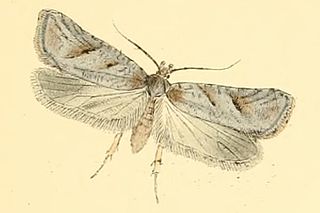
Exaeretia allisella is a moth of the family Depressariidae. It is found in most of northern and central Europe, Siberia, the Russian Far East, Mongolia and northern and central China.

Exaeretia is a moth genus of the superfamily Gelechioidea. It is placed in the family Depressariidae, which is often – particularly in older treatments – considered a subfamily of Oecophoridae or included in the Elachistidae.
Exaeretia bignatha is a moth in the family Depressariidae. It was described by Shu-Xia Wang and Zhe-Min Zheng in 1998. It is found in China (Heilongjiang).
Exaeretia exornata is a moth in the family Depressariidae. It was described by Shu-Xia Wang and Zhe-Min Zheng in 1998. It is found in China (Heilongjiang).
Exaeretia magnignatha is a moth in the family Depressariidae. It was described by Shu-Xia Wang and Zhe-Min Zheng in 1998. It is found in China (Heilongjiang).
Exaeretia crassispina is a moth in the family Depressariidae. It was described by S.X. Wang in 2005. It is found in China (Qinghai).
Exaeretia deltata is a moth in the family Depressariidae. It was described by S.X. Wang in 2005. It is found in China.
Exaeretia longifolia is a moth in the family Depressariidae. It was described by S.X. Wang in 2005. It is found in China (Heilongjiang).
Exaeretia canella is a moth in the family Depressariidae. It was described by August Busck in 1904. It is found in North America, where it has been recorded from California, Washington, from British Columbia to Quebec, Idaho, Colorado, Montana, Wyoming, Michigan, New Hampshire, New York and Connecticut.
Exaeretia fulvus is a moth in the family Depressariidae. It was described by Lord Walsingham in 1882. It is found in North America, where it has been recorded from New Brunswick and Maine to British Columbia, south to Arizona and New Mexico.
Exaeretia gracilis is a moth in the family Depressariidae. It was described by Lord Walsingham in 1889. It is found in North America, where it has been recorded from North Dakota to Texas and in California, Colorado, Minnesota, Oklahoma, Wisconsin and Iowa.
Exaeretia indubitatella is a moth in the family Depressariidae. It is found in Mongolia and Russia.
Exaeretia liupanshana is a moth in the family Depressariidae. It is found in China (Ningxia).
Exaeretia nechlys is a moth in the family Depressariidae. It is found in North America, where it has been recorded from Arizona to California and in Nevada.
Exaeretia nivalis is a moth in the family Depressariidae. It is found in North America, where it has been recorded from Montana, Wyoming, Washington, British Columbia and Alberta.
Exaeretia scabella is a moth in the family Depressariidae. It is found in North America, where it has been recorded from Ohio.
Exaeretia sordidella is a moth in the family Depressariidae. It is found in North America, where it has been recorded from British Columbia.
Exaeretia thoracefasciella is a moth in the family Depressariidae. It is found in North America, where it has been recorded from California to Washington.
Exaeretia thoracenigraeella is a moth in the family Depressariidae. It is found in North America, where it has been recorded from California and Oregon.
Exaeretia umbraticostella is a moth in the family Depressariidae. It is found in North America, where it has been recorded from South Dakota and British Columbia to Texas and California.
